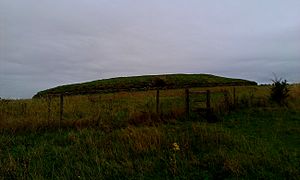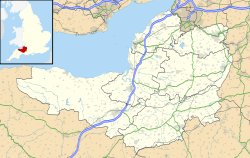Stoney Littleton Long Barrow facts for kids

Stoney Littleton Long Barrow in 2016
|
|
| Alternative name | Bath Tumulus and Wellow Tumulus |
|---|---|
| Location | near Wellow |
| Region | Somerset, England |
| Coordinates | 51°18′48″N 2°22′54″W / 51.31335°N 2.38168°W |
| Type | Chambered long barrow |
| History | |
| Periods | Neolithic |
| Site notes | |
| Condition | intact |
| Public access | yes |
The Stoney Littleton Long Barrow is an amazing ancient burial place from the Neolithic period. This means it was built a very long time ago, around 3500 BC, during the Stone Age. It's also known as the Bath Tumulus or Wellow Tumulus.
This special structure is a type of chambered long barrow, which is a large mound of earth and stones covering a tomb with several rooms inside. It's located near the village of Wellow in Somerset, England. The Stoney Littleton Long Barrow was recognized as an ancient monument in 1882, making it one of the first sites to be protected by law in England.
Contents
What is a Long Barrow?
A long barrow is like a giant, ancient burial mound. People in the Neolithic period built these huge structures to bury their dead. They were often used for many people, not just one.
The Stoney Littleton Long Barrow is about 30 metres (98 ft) long. Inside, it has a main passage, or gallery, that is 12.8 metres (42 ft) long. This gallery leads to three pairs of smaller rooms on the sides and one room at the very end. These were the burial chambers where people's remains were placed.
Where to Find It
The barrow is about 1.5 kilometres (0.93 mi) southwest of Wellow village. It sits on a limestone ridge, which is a raised area of land, and looks out over the Wellow Brook.
You can visit the barrow! There's a path from a car park at Stoney Littleton Farm that leads right to it. It's a great place to imagine what life was like thousands of years ago.
A Look Back in Time: History of the Barrow
Long barrows like Stoney Littleton were built between 4000 and 2500 BC. They were important places for rituals and for burying people in a special way. Stoney Littleton Long Barrow was likely built around 3500 BC.
The tomb was first opened around 1760 by a local farmer. He was looking for stones to build roads. Later, in 1816-17, two archaeologists named John Skinner and Richard Hoare explored the site. They found bones from several different people inside. Some of these bones had even been burned.
In 1858, the mound was repaired by Thomas Joliffe. Some of the items found during the early explorations are now kept in the Bristol City Museum and Art Gallery.
Since 1884, the Stoney Littleton Long Barrow has been looked after by the government. Today, English Heritage manages the site and provides information for visitors. More work was done in 1999 and 2000 to help preserve the barrow and learn more about it.
Inside the Ancient Tomb
Severn-Cotswold tombs are known for their carefully built, long, trapezoid-shaped mounds. The Stoney Littleton Long Barrow is made from local stones like Blue Lias and Forest Marble. These stones were found within 8 kilometres (5.0 mi) of the site.
The barrow is about 30 metres (98 ft) long and 15 metres (49 ft) wide at one end. It stands almost 3 metres (10 ft) high. The passage inside and the entrance are lined up towards where the sun rises in midwinter. The roof of the passage is made of stones that overlap, like steps.
One cool detail is a fossil ammonite impression that decorates one of the stone doorjambs at the entrance. It's like a natural piece of art from millions of years ago!
Interestingly, the barrow isn't on flat ground. It looks like it's gently sliding down the side of a hill.
Gallery










